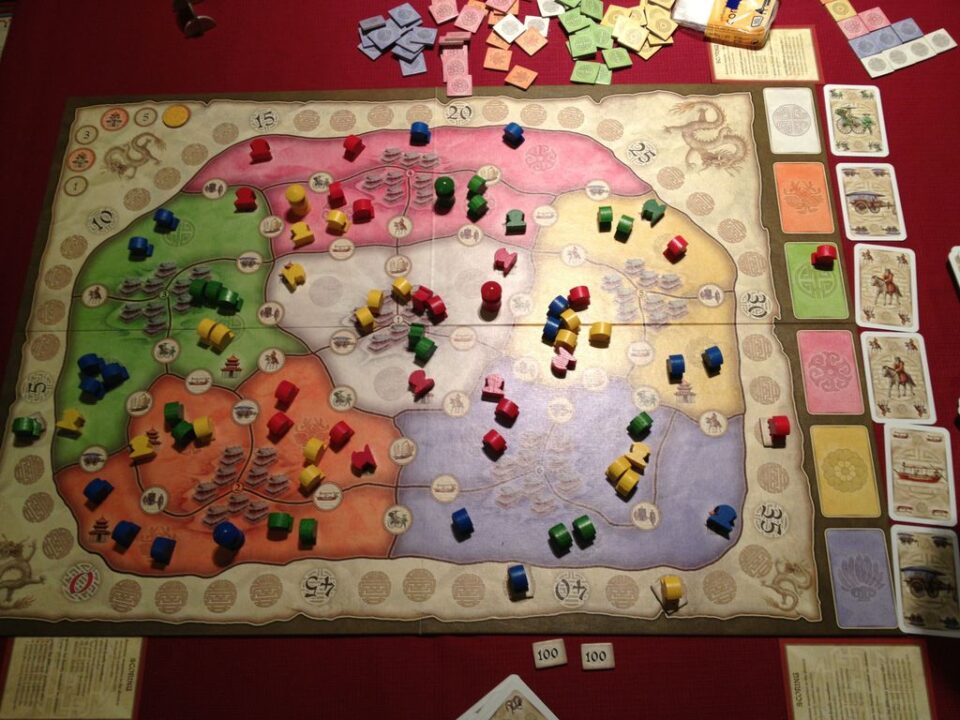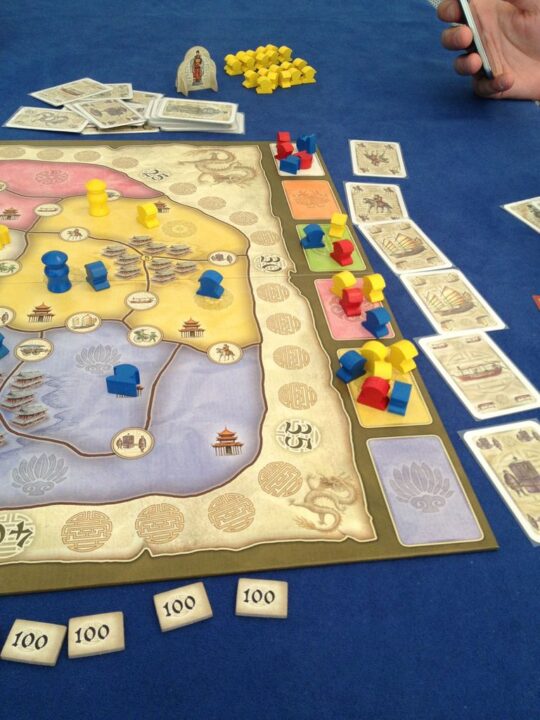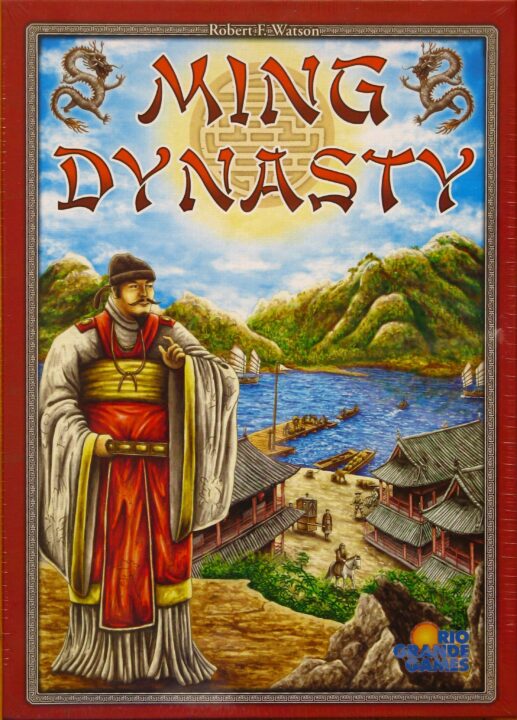If you like games where clever moves matter more than lucky dice rolls, you might want to check out this review. I’ve wrangled my friends for some intense sessions and ended up with a lot to say about this one. From sneaky player moves to a theme so rich you’ll think you’re halfway to China, this review digs into everything you need to know before you decide to take home Ming Dynasty. Let’s see if it’s worth a spot on your shelf—no emperor’s decree required!
How It Plays
Setting Up
First, toss the board on the table and hand out player pieces. Everyone gets their family tokens, cubes, and some coins. Shuffle the event cards—don’t drop them in your coffee like I once did. Place the emperor token on his starting spot (he’s the boss, so treat him well).
Gameplay
You take turns moving influence around China. Every round, you place officials, build pagodas, grab cards, and sometimes mess up your friends’ plans—sorry, Dave! Events can shake things up, and you’ll need to balance getting new regions and keeping your folks happy. Most turns, you have a few smart options, but sometimes you just wish the event deck would take a nap.
Winning the Game
Once you play through the set number of rounds (no, you can’t keep going just because you’re losing), everyone counts up points from their regions, pagodas, and collected goodies. Whoever has the most points claims victory as the Ming master! But watch out—one well-timed move can ruin your whole empire. Just ask my cousin Mike.
Want to know more? Read our extensive strategy guide for Ming Dynasty.
Balance and Fairness in Ming Dynasty: Is It a Ruler or a Tyrant?
Game balance in a board game is like peanut butter on toast—spread it right and everyone’s happy, but mess it up and things get stuck in your teeth. When my group sat down to play Ming Dynasty, we were hoping for a smooth, nutty experience, not a dry disaster. I’ll start with the good: Ming Dynasty does a solid job of letting players carve out their own path to victory, and for the most part, no one feels left behind because of some runaway leader mechanic. There’s just enough tension in the area control fights that it’s never clear who will win until the end. This tickled me because my friend Dave usually tries to conquer everything in his path, but even he couldn’t bully his way to victory this time.
I do have to mention, though, there’s one little fly in the fairness ointment. The event cards that pop up each round can shake things up, and while sometimes that’s fine, once or twice we had a player completely wrecked by a bad event card. That can sting. It’s not the worst luck-based mechanic I’ve seen, but it does give me a bit of a side-eye. You can play well, plan ahead, and still get kicked in the shins by a random card. I’m not keen on that sort of thing—I want to win or lose on my own moves, not because the deck hates me.
If you love games where skill, not luck, sends you to the winner’s circle, Ming Dynasty mostly delivers, but keep a lucky rabbit’s foot nearby. Next up, I’ll tell you how this game gets people glaring, plotting, and maybe even forming a secret alliance or two…

Player Interaction and Strategy: Scheming in the Ming Dynasty
If you like plotting, trickery, and a bit of friendly backstabbing, Ming Dynasty is calling your name. The game isn’t just about grabbing pretty provinces; it’s about reading your friends, guessing their plans, and sometimes ruining their hopes for a peaceful round. During my first game night, my friend Lisa spent more time glaring at me than planning her moves—and I deserved it. In Ming Dynasty, player interaction is front and center. Every turn, you choose where to send your troops and nobles, often contesting the same areas as your rivals. It feels a bit like a silent auction, but with more historical hats and sharper elbows.
What really makes the game interesting is the way you have to anticipate not just what you want, but what your opponents are after. You have to keep track of their objectives and moves, and it pays to be sneaky. I learned this the hard way after putting all my eggs in one basket, only to have my empire crumble thanks to my overly predictable tactics (and my buddy Dave, who apparently has a degree in treachery). There’s no single dominant strategy in Ming Dynasty, either. You can win by spreading out, focusing on certain provinces, hoarding special action tokens, or just plain outwitting your tablemates. The best victories feel earned, not gifted by random chance, which I love.
Next, I’ll take a look at the theme and artwork quality—so let’s see if those ancient hats look as good as the gameplay feels!

Theme and Artwork Quality in Ming Dynasty: Travel Back in Time, Almost
Let me tell you, when I first opened Ming Dynasty, I half expected a silk robe and a bowl of rice to fall out of the box. The theme is on point. You take on the role of an ambitious Chinese leader during—you guessed it—the Ming Dynasty, wrestling for power across ancient provinces. I could almost hear the clatter of old coins and the distant mutter of court officials (or maybe that was just my hungry stomach).
The game board is a work of art that makes geography class look like a bad doodle. It has a map of China painted with lush rivers, delicate provinces, and, best of all, actual pagodas you can place. These wooden pagodas are so cute, my cat tried to steal one. The designers didn’t mess about; the cards and tokens are covered in period-style calligraphy and smart symbols that tie back to the 14th-century vibe. Nothing breaks the immersion, except maybe my cousin Dave’s phone going off with a pop song in the middle of a tense round.
The attention to detail really shines. Even the player reference cards look like little scrolls. The color palette is calming but never dull—lots of reds, greens, and golds. It feels like you’re plotting on an ancient tapestry, not just cardboard. Sure, some might say the artwork is more functional than jaw-dropping, but for me, it nails the balance: pretty enough to impress, simple enough to keep things clear.
If you’ve ever wanted to play emperor for an hour or so—without running afoul of any real palace intrigue—Ming Dynasty’s art and theme are a strong reason to pick this one up. Grab your ceremonial hat, because next time, I’ll talk about how often you’ll want to bring this game out and if the pace will keep you awake or have you napping by the pagoda.
Replayability and Game Pacing in Ming Dynasty: Will You Come Back for More?
If you’ve ever played a board game and thought, “Wow, that hour of my life is never coming back,” you know how important replayability and pacing are. Ming Dynasty dodges this disaster pretty well, though not without a hiccup or two.
First off, replayability in Ming Dynasty is surprisingly strong. There’s lots of room to try new strategies each game. My group never picked the same path to victory twice, which kept things fresh. The board shifts every round thanks to the wild province events—sometimes you’re rich in power, sometimes you’re scrambling like a chicken after a firecracker.
BUT—and this is a big but—the event cards can sometimes throw a bowling ball at your best-laid plans. One game, I felt like a master tactician. Next game, I lost my entire army because of a random event and spent the next 40 minutes sulking (and eating chips). So, the replayability is great as long as you don’t mind the odd game where fate smacks you in the face.
Now, about pacing: Ming Dynasty moves at a good clip with the right group. Turns are quick and you don’t sit staring at other folks doing math for ages. If someone has analysis paralysis, though, things can slow down faster than my grandma going up stairs. Still, most games I played wrapped up in about 90 minutes, which is just the right amount of time to feel smart, but not exhausted.
So, do I recommend Ming Dynasty? If you like a mix of strategy and the occasional ridiculous plot twist, absolutely give it a go. Just bring snacks for the unlucky.
Conclusion
Ming Dynasty brought my friends and me back to ancient China with clever strategy, lovely artwork, and some sneaky moves. I loved the player interaction and the way every choice mattered, even if the random event cards made me want to flip the table once or twice. The game keeps a good pace and offers plenty of replay value if you enjoy outsmarting your buddies. If you hate bad luck, take a deep breath—those cards can break your heart. But if you like a fair challenge with a touch of chaos, Ming Dynasty is worth a spot on your shelf. That wraps up my review. Now, who’s up for another round?


